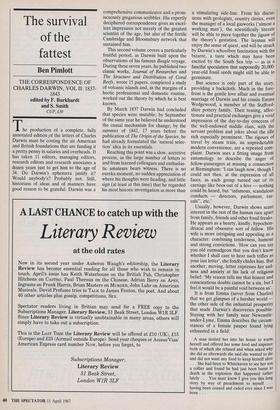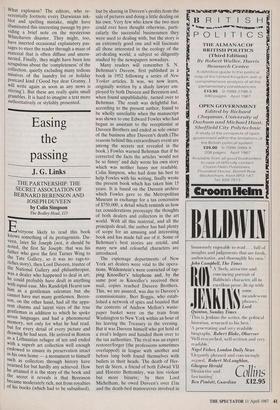The survival of the fattest
Ben Pimlott
THE CORRESPONDENCE OF CHARLES DARWIN, VOL II: 1837- 1843 edited by F. Burkhardt and S. Smith
CUP, £30
The production of a complete, fully annotated edition :of the letters of Charles Darwin must be costing the six American and British foundations that are funding it a pretty penny in salaries and overheads. It has taken 11 editors, managing editors, research editors and research associates a dozen years just to get him to the age of 34. Do Darwin's ephemera justify it? Would anybody's? Probably not. Still, historians of ideas and of manners have good reason to be grateful. Darwin was a comprehensive communicator and a prom- iscuously gregarious scribbler. His expertly deciphered correspondence gives an excel- lent impression not merely of the greatest scientist of the age, but also of the fertile Cambridge and Bloomsbury network that sustained him.
This second volume covers a particularly fruitful period, as Darwin built upon the observations of his famous Beagle voyage. During these seven years, he published two classic works, Journal of Researches and The Structure and Distribution of Coral Reefs, wrote 15 papers, completed a study of volcanic islands and, in the margins of a hectic professional and domestic routine, worked out the theory by which he is best known.
By March 1837 Darwin had concluded that species were mutable; by September of the same year he believed he understood the causal mechanism for change; by the summer of 1842, 17 years before the publication of The Origin of the Species, he had already formulated the 'natural selec- tion' idea in its essentials.
Reaching this point was a slow, accretive process, as the large number of letters to and from learned colleagues and enthuslas- tic amateurs bears witness. There is no eureka moment, no sudden appreciation of where his thoughts were heading, and little sign (at least at this time) that he regarded his most historic investigation as more than a stimulating side-line. From his discus- sions with geologists, country clerics, even the manager of a local gasworks ('almost a working man'), the scientifically literate will be able to piece together the jigsaw of the theory's gestation. The layman will enjoy the sense of quest, and will be struck by Darwin's schoolboy fascination with the bizarre, a taste which may have been excited by the South Sea trip — as in a fanciful speculation that supposedly 20,000- year-old fossil seeds might still be able to germinate.
But science is only part of the story, providing a backcloth. Much in the fore- front is the gentle love affair and eventual marriage of Darwin and his cousin Emma Wedgewood, a member of the Stafford- shire pottery family. Their teasing, affec- tionate and practical exchanges give a vivid impression of the day-to-day concerns of the well-endowed middle class, with the servant problem and jokes about the idle rich especially prominent. The rigours of travel by steam train, an unpredictable modern convenience, are a repeated com- plaint. Darwin uses a fitting image from entomology to describe the anger of fellow-passengers at missing a connection at Birmingham: 'I can laugh now, though I could not then, at the expression of all faces, as each group turned out of its carriage like bees out of a hive — nothing could be heard, but "infamous, scandalous conducts — directors, parliament, ras- cals", etc.'
Usually, however, Darwin shows scant interest in the rest of the human race apart from family, friends and other fossil freaks. He appears as a hearty, kindly, hypochon- driacal and obsessive sort of fellow. His wife is more intriguing and appealing as a character: combining tenderness, humour and strong convictions. 'How can you say you old curmudgeon that you don't know whether I shall care to hear such trifles as your last letter', she fondly chides him. But another, moving, letter expresses her sad- ness and anxiety at his lack of religious belief: 'My reason tells me that honest and conscientious doubts cannot be a sin, but I feel it would be a painful void between us'. It is from Emma (never from Charles) that we get glimpses of a harsher world — the other side of the industrial prosperity that made Darwin's discoveries possible. Staying with her family near Newcastle- under-Lyme, Emma describes the circum- stances of a female pauper found lying exhausted in a field:
A man invited her into his house to warm herself and offered her some food and sixpence both of which she refused and when asked why she did so afterwards she said she wanted to die and did not want any food to keep herself alive . . She had been to Whitehaven to see her son a collier and found he had just been burnt to death in the explosion that happened rather lately . . . You must know I give you this long story by way of preachment to myself . - • having been coaxed and caded ever since I was born. . .
What explosion? The editors, who re- verentially footnote every Darwinian ink- blot and spelling mistake, might have illuminated this interesting passage by pro- viding a brief note on the mysterious Whitehaven disaster. They might, too, have inserted occasional explanatory pas- sages to steer the reader through a maze of material that is often diffuse and uncon- nected. Finally, they might have been less scrupulous about the 'completeness' of the collection, quietly excluding many tedious missives of the laundry list or holiday Postcard kind (`Good bye dear Granny. .I will write again as soon as any news is stirring'). But these are really quite small grumbles. It is hard to imagine a text more authoritatively or stylishly presented.

























































 Previous page
Previous page